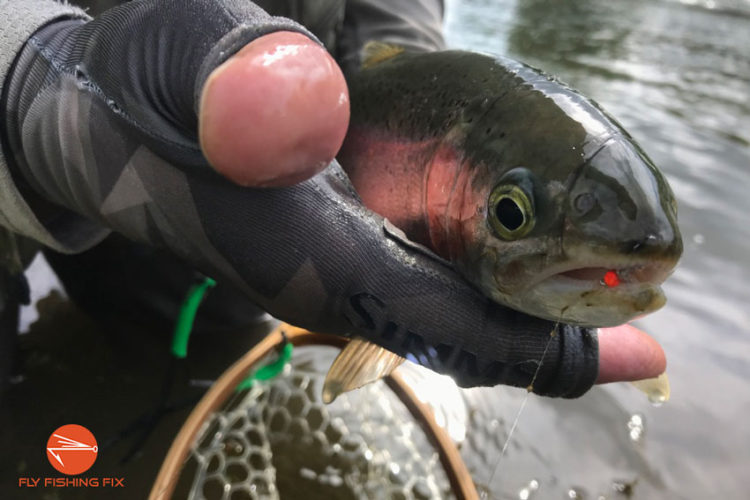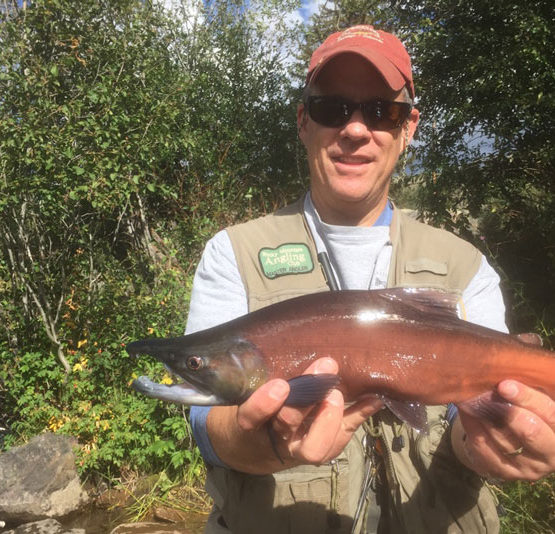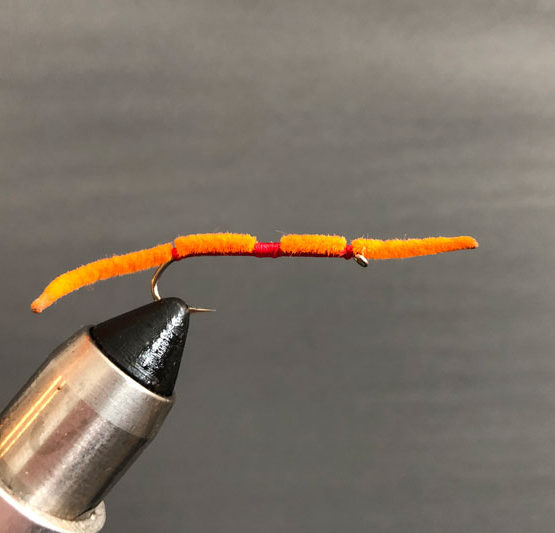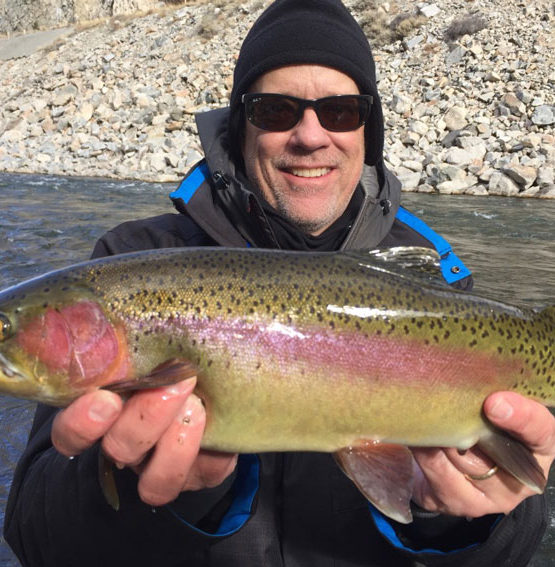Are you looking for some tips on fly fishing with small flies? Then this post is for you!
We anglers suffer from a common tendency: we project human characteristics into the trout we stalk. Since we like a big steak, a big apple, a big piece of pie, we tend to think trout want the same thing. Naturally! Bigger is better, right? Well, not always.
When it comes to fly fishing for trout, using a smaller fly is often better. And if smaller is better, sometimes miniscule is killer! But since we’re also prone to shy away from using them, here are a bunch of tips for fly fishing with small flies.
Disclaimer: This post may contain affiliate links, meaning we will receive a small commission (at no cost to you) if you click through and make a purchase.General Tips For Fly Fishing With Small Flies
I have always been amazed that many whale species subsist on a diet of tiny krill and plankton. I’ve read that a large blue whale consumes up to four metric tons of krill every day!
Think of tiny aquatic edibles — fly larvae, crustaceans, micro worms, and the like — as a trout’s version of krill and plankton. Sure, this may not be their everyday diet, but I can’t tell you how often I’ve seined a river only to find millions of the tiniest critters crawling or squirming around on my screen.
I’m not a fan of pumping a trout’s stomach. I mean, how would you like it if someone came along with a big vacuum tube, jammed it down your throat, and sucked out that lovely steak, caesar salad and chocolate cake dinner you just ate? But on the occasions I’ve felt compelled to do it (usually on very slow days when nothing obvious is hatching), and it’s uncanny how often the stomach pump spills out a thousand tiny organisms. It’s even more amazing that, when that happens, there is always a high degree of consistency. For example: the little creatures may all be black, olive or tan, and all are size 22.
So, when trout are playing it cagey; when they’re acting finicky; when a dragonfly hatch-and gorge ain’t-a-happenin’, it might just be time to get tiny.
Oh, and, by the way, as a good fly fisher, you must get over the misguided notion that trout won’t be able to see a tiny fly as it goes by in a swift current. Trout, like sharks, are amazingly well-adapted, predatory carnivores. They see small edibles just fine, thank you very much!
Related Content:
- 9 Things To Learn About Fly Fishing
- Do You Need Tippet For Fly Fishing?
- 25 Best Dry Flies For Colorado Fly Fishing
- 10 Reasons You Should Take Up Fly Fishing
- How To Tie A Double Nymph Rig? A Step-By-Step Guide
- 25 Tips For Fly Fishing Small Streams And Creeks
Learn To Properly Handle Small Flies
Tied with thin thread, dainty, biot wings and wispy tail-mimicking materials, small flies are, of course, delicate. When handling them, especially if, like me, you’ve been blessed with oddly large digits, it’s important that you take care not to crush their wings, bend their tails or otherwise mangle them before a big trout gets to. Therefore, you must learn the following…
Put Small Flies Into Your Fly Box Properly
Since I’ve come to terms with how well small flies tend to produce fish-catching success when nothing else is working, I not only keep a good supply of them in my fly box, I’m careful to add them to my box with great care.
A good set of tweezers comes in rather handy for this purpose. However, whether using tweezers or not, it’s best to gently pinch the fly below the body thread, and, if you can, under the tail. In other words, try to pinch at the clean hook area of the fly.
If you do use tweezers, be careful to tweeze the hook in such a way that, if you accidentally apply too much pinch-pressure, the fly doesn’t jump out of the pincers, fly across the room, and land in your shag carpet. Such a fly will never be found, that is, until your barefoot and now-wailing daughter finds it embedded in her toe three months later.
Depending upon the kind of fly box you’re using, try to slot the small fly in such a way as to not jack-up wings or tail, especially when your box is closed.
It truly comes down to personal preference, but most anglers will recommend you anchor your fly with the point of its hook aimed into the slot as the rest of the fly arcs over the foam. In other words, don’t shove it into its slot butt first.
Take Small Flies Out Of Your Fly Box Properly
Once I’ve made my small fly selection, the same rules apply when removing them from my box. Simply put, don’t mangle the little sucker. Handle it the same way you put it in.
However, since, for obvious reasons, I don’t love using tweezers to remove a fly while wading in a river, I will either use my fingers or, even better, clamp the hook of the chosen fly with my tethered and clamping forceps. That way, I reduce the chance of dropping and losing the fly, even if I fumble my box or forceps.
Additionally, when a small fly is securely clamped into the tip of my forceps, not only does it protect the fly from my destructive, ape-like fingers, it makes it easier to thread hair-like tippet through its eye, and makes tying the requisite Clinch Knot much easier. Win, win, win!
Join Fly Fishing Fix, Today!
Tips For Tying Small Flies To Your Tippet
Once you’ve overcome your hesitancy to go small, you will have opened the door to catching a lot more fish. Here are several good tips to help you rig up for small fly presentations:
Opt For Lighter Tippet
Thanks, Captain Obvious! Using 3X tippet with a #22 fly is like cheating on your taxes; it can be done, it’s just not a great idea. If trout are feeding on delicate flies, it’s best to present yours to them at the end of an angel’s hair, not a tow rope.
That said, there are situations when heavier tippet won’t keep a hungry trout from hitting a small fly. So, if you’re getting a lot of strikes followed by a lot of break-offs, inch up to the next heaviest tippet until you find the magic combination.
Use Readers And Magnifying Flip Downs
As a near-sighted individual, my aging eyes still see small things very well up close, even tiny flies and tippet. Therefore, I may not be the best one to extol the virtues of readers and flip focal magnifiers.
Nevertheless, I’ve been told by those who use them that they are worth their weight in gold. Some versions attach to the top of your glasses or sunglasses, but the ones that clip to the bill of your cap and flip out of the way when not in use, seem to get the best reviews. Orvis, L.L. Bean and Cortland all offer good flip focal magnifiers for right around $20.
Find A Dark Backdrop
Magnifiers or not, one thing that’s really hard to do is to tie a small fly to a light tippet when you’re doing so against a light and/or swirly, glare-splashed backdrop (like the surface of a river).
Regardless of fly and tippet size, it’s always helpful to work on your rig against a dark and steady backdrop. If you’re standing in a river, this is easily done by turning your body to shadow the sunlight, and using the river bank as your knot-tying backdrop. That said, any dark and steady backdrop will do.
Beware Of The Wind
I sometimes think that, when I close my fly box, all my flies instantly animate, wiggle out of their slots and throw a tiny kegger. How else would you explain how so many of them get loose between the time I carefully place them in there and the next time I open it, hmmm??
Just know that, when you open your fly box on a windy day, some of the tiny party-goers — the ones who didn’t make it back to bed in time — can easily sail away with one inopportune gust.
Because I’ve found myself wasting way too much time doing so, you can trust me when I tell you that you will never, ever, ever, ever find a size 20 RS2 that got blown out of your fly box, no matter how long you dig through the jumble of reeds it fell into.
Fluorocarbon vs. Nylon
Ah, the age-old story that, literally, only fly anglers care about, is whether to use fluorocarbon or nylon tippet.
Fluorocarbon sinks better, is more supple, and more invisible to fish underwater. It’s also more expensive, has comparatively less tensile strength and is more easily abraised. In my opinion, fluorocarbon tippet, particularly in the lighter test ranges, is also a little harder to thread through a small fly’s eyelet and knot. Multiply the previous sentence by at least a factor of five if it’s super windy.
Nylon offers pretty much the opposite of all of the above, but is generally not as invisible to trout. The rule of thumb, therefore, is to use nylon tippet for dry fly presentations and fluorocarbon tippet for nymphing rigs.
Though, to be perfectly honest, I sometimes get lazy and forgetful, and, as such, will unintentionally use the incorrect type of tippet for the type of fly fishing I’m doing. I really don’t think it’s hurt me that much either way. I say, if you’re making good presentations and getting strikes, go with whatever floats your boat!
“Improve” Your Clinch Knot
The generally accepted twist total for a standard Clinch Knot is five to six. If you’re working with smaller flies and lighter tippets, you can get away with a couple more twists. Go with six or seven or, if you feel compelled to stick to five, be sure to improve your knot by running the tag end back up through the first loop.
Always be sure to give your fly a good tug to cinch down your knot. If it looks or feels like it might unravel, cut it off and start over. There’s nothing quite as vexing to an angler as losing a big trout, only to see a telltale tippet squiggle where his or her fly once was.
Ask anyone, a clean break is always better than a squiggle.
Try The Overhand Loop Knot
When tying on a small nymph, you might try experimenting with an Overhand Loop Knot. Easily tied, the loop allows for more nymph movement. One drawback of the overhand loop knot is that, at least in my experience, the loop has a tendency to break more readily than a well-tied Clinch Knot. Give it a try and let your own experience dictate how often you use it.
Tips For Playing And Netting Fish On Small Flies
Holy crap! You gave this tiny fly thing a shot, and, lo and behold, you’ve hooked a big one! Now what?
Maintain Good Line Tension
Because of the usually narrower gap between small fly body and small fly hook, your hook-sets may not be very sturdy.
Often, small fly sets are delicate at best. In other words, your itty-bitty fly might have caught the fleshy exterior of a trout’s mandible and is hanging on for dear life. Even if you did make a good hook-set, a mere millisecond of line slack can be all a trout needs to kick you to the curb.
In any fish-on situation, keeping consistent line tension is a must. However, if, like me, you enjoy netting fish as much as you do catching them, maintaining a taut and steady line is particularly important when fishing with small flies.
Use A Soft Hand And Drag Adjustments To Minimize Snap-Offs
Speaking of a steady line, your netted trout count will climb in inverse proportion to the reduction in line movement while you’ve got one on. When playing a fish, it’s just as important to minimize sudden jerks as it is to reduce left to right rod movements.
While keeping a tight line, I try to think about having a soft hand and flexible wrist. Whereas, if a trout I’m playing decides to breach and thrash from side to side, this thought helps me give a little so that I don’t lose it to a sudden snap off.
In the same vein, level-headed anglers make good use of their reel’s drag adjustment. If a fish wants to run, a slight reduction in drag will allow for that, while, at the same time, reducing the likelihood of a line snap. Conversely, if your drag is set too loose, quickly tighten it a tad before said trout takes you out so far that you’ll never get it back in.
Learning to minimize rod and line movement while making minor drag adjustments is especially important when fly fishing with small flies.
Don’t Overplay The Fish
Overplaying a hooked trout is not only bad for the fish, it can be bad for your ego.
When fishing with small flies, your success improves with how fast you get the hooked fish into your net. That is not to say that you should horse the thing in as fast as you can reel and tug. That’s just a line snap waiting to happen.
Instead, experienced anglers develop a sixth sense that tells them when it’s okay to let a fish run and when it’s time to “give it the wood.” Although it may sound counterintuitive, with a small fly and light tippet, you will want to place a bit more emphasis on wood than run.
Walk It Downstream
At some point in my youth, I received a great deal of fly fishing instruction that I’ve long since had to toss aside. One such teaching said that, when playing a trout, it was wise to remain stationary and play the fish back in to where I was standing. Although that may work just fine with smaller fish, looking back, it’s no wonder I lost a lot of larger fish while trying to remain stationary.
Indeed, the opposite technique tends to work better. Keeping line movement to a minimum, it is often beneficial to walk your hooked friend downstream a bit, especially if you can walk it into an area of slower moving water for netting (and photographing).
In certain situations — big and slippery rocks, fallen logs, dense overhead branches, other anglers, to name just a few — it’s not as easy to walk a fish downriver, but if you’ve hooked a big fish on a small fly, this technique may help you get it into the net more often.
Be Careful Netting
Your date has gone phenomenally well. You’ve played it beautifully, and the chemistry is strong. But now you’ve arrived at the moment of truth: the goodnight kiss. When it comes to netting a well-played fish, the same principle holds true: you can really blow it with a sloppy one!
With bigger flies and heavier tippet, you might get away with a sloppy netting job. Not so with small flies and lighter tippets. I can’t tell you how many times I’ve lost a nice fish at the net, and it’s always because I got just a skosh lazy or complacent. Accidentally hit a frayed tippet with my net’s rim? Goodbye, Mrs. Rainbow. Try to sneak my net up slowly from behind? See ya later, Mr. Brown.
Regardless of fish, fly or tippet size, the best way to net a hooked trout is to do so swiftly and confidently, in one fell swoop, with net approaching from the nose end of the fish. One of the biggest mistakes I see fly fishers make is to try to net fish with a tail-end net approach, especially a slow one.
Fish swim where they’re aimed, so why would you want the trout you played so well to dart away from your net rather than directly into it? When I learned to net fish from the front, being careful not to jab my line with my net when doing so, my landed fish count soared. Yours will too.
A Few Tips For Fishing Small Dry Flies
Fish With One Fly
When fishing small dry flies, start with just one, or stay with just one. It’s hard enough to get a good drift on a small dry fly, why complicate it by adding another? Fishing only one dry fly also makes for easier, quicker changes should a new hatch arise.
Avoid Using Fluorocarbon Tippet
Because it sinks more readily and can pull your small fly under with it, fluorocarbon tippet isn’t the best material to use for a small dry fly presentation. Go with standard nylon tippet for greater success. By the way, using a longer tapered leader will also help.
Use High-Visibility Flies
I don’t care how old you are, it’s just not easy to see a tiny dry fly any further than about five feet away. It helps to use flies with high visibility features, like a bright orange parachute.
Don’t worry about a high-visibility feature scaring away trout. When it comes to dry flies, trout are looking up to see them. A bright sky backdrop produces more of a silhouetted profile, thus, fish aren’t able to make out such details.
Additionally, high vis features are always located on the upper side of the fly.
A Few Tips For Fishing Small Nymphs
Use Fluorocarbon Tippet
For the reasons noted previously, fluorocarbon tippet is ideal for nymphing with both small and large nymphs. Since it performs extremely well while still offering excellent durability and forgiveness, we prefer Rio Fluoroflex Plus tippet for all nymphing situations.
Related Posts:
Fish A Dry Dropper Rig
One of the most fun rigs to fish is the dry dropper. Simply, this is a double fly rig using a larger dun, attractor or terrestrial pattern as the lead bug and trailing a smaller nymph pattern off of the lead fly’s hook bend with a second section of tippet.
The lead dry serves the purposes of drawing attention, inducing strikes, and providing strike indication for the trailing nymph. If conditions favor this rig setup, this is a great way to get started fishing with tiny flies.
Related Posts:
Fly Fishing With Small Flies: Final Thoughts
One of the things writing about fly fishing always reveals to me is how much there is to cover and just how much more there is to learn!
I hope you’ve enjoyed this post, and that you’ll use the set of tips in this article as an educational springboard to becoming your own expert on fly fishing with small flies.
Whether beginner or expert, and as long as they are offered in the clean and authentic spirit we anglers appreciate, we invite and encourage reader contributions and comments.
And, if you haven’t done so already, be sure to join our growing list of Fly Fishing Fix freaks. It won’t be long before we’re a full-on movement!
In the meantime, may your flies be tiny and your fish be enormous!
Join Fly Fishing Fix, Today!










